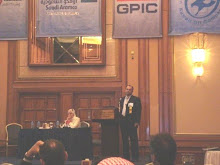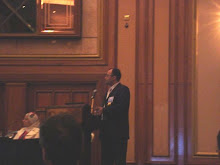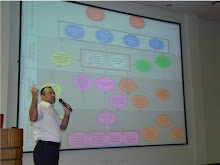We are looking for a simple cultural change process to bridge our present into the desired future; a method that can be “strategically staged” and easily implemented by our managers. Partnering provided answers to all these and more as explained hereafter.
Considering the Key elements of partnering as a start: commitment, equity, trust, development of mutual goals and objectives, implementation, continuous evaluation, timely responsiveness. These foster organizational development as shown in fig. below.
Figure: Partnering-adopted from Fisher, 1990
First: A Contract Friendly Process
Partnering uses a structured workshop process as a tool for building relationships and driving team performance. It presents a moral contract (charter) between project stakeholders committing to act with a “best for project” perspective.
Due to its moral nature, the partnering contract does not contradict with other contractual relationships but complements them to the best interest of all stakeholders (replace legalistic win-lose with a synergistic win-win culture). Statistics support this declaration since litigations decreased significantly when partnering was introduced.
Second: A Performance Driver
It is precarious to maintain high performance in our organization. There are some “momentary” performance boosts like technological advantages, great leaders, downsizing, and the like (Kotter and Haskett, 1992). However it is partnering that provides the two key aspects for “maintaining” high performance:
o Organizational Flexibility
o Motivating organizational people to maintain potential.
Third: National Cultures’ Integration
As stated earlier, partnering is based on some values like trust, open communications and shared objectives; different nations have these values at different levels of their cultural behaviors. Therefore, the depth of the Organizational cultural change process will vary according to the gap to be closed between Partnering and National values.
Partnering can extend either horizontally (across departments/equal stakeholders) or vertically (along the hierarchy). In both cases, we need to “accept” the existing national culture’s values and modify the partnering process to better fit with these values. The importance of this concept escalates when we work across different cultures (Hofstede, 1980)
with more to follow on this topic,
samer
About The Author

- Eng. Samer el Barakeh, MPM, PMP
- Samer el Barakeh was born in Lebanon, 1973. He completed his Bachelor in Engineering-CCE at Beirut Arab University-Lebanon in 1996 with honours. Samer was granted Masters Degree in Project Management (MPM) from the University of Sydney-Australia with honours. He also gained the Project Management Professional (PMP) Credential from The Project Management Institute (PMI). Samer is a member of the Order of Architects and Engineers in Lebanon since 1996, The Project Management Institute (PMI), Arabian Gulf Chapter (AGC-PMI) and Lebanon Chapter-PMI. During his 13 years of professional experience in Lebanon, Australia and Saudi Arabia, Samer held many positions among them: Telecommunication Site Engineer, Site Manager, Low Current Service Head, and he is currently Senior Systems Analyst at the General Project Construction Division. Samer is a Project Management Consultant and Training Provider for universal organizations like Business Management Consultants (USA) www.bmc-online.com and PMCTQuest (Canada) www.pmctquest.com Samer is a Registered Training Provider for Project Management Professional (PMP), and he provides training in Program Management, Portfolio Management,PMO...
Select a topic to view content
- A comparison between PMBOK and Prince2 Methodologies and reflection on case study examples (1)
- ABC to Avoid Project Failure (1)
- Business Case and Quantitative Benefits (1)
- Do we need more 'Planners' ? (1)
- Fasilitator in Partnering-A Coincise Shot (1)
- How to Ensure Stratgic Alignment of Our Projects? (1)
- Individual Dissimilarity and Team Work (1)
- Knowledge Management (1)
- Maturity Models-The Pros and Cons (1)
- Organizational Advantages from Partnering (1)
- Organizational Maturity: Lets Head Upwards... (1)
- Organizational Strategy and Project Alignement (1)
- Practical Solutions 1 of 6: Introduce RMMM (1)
- Practical Solutions 2 of 6: Facilitate Change to Perk up Maturity (1)
- Practical Solutions 3 of 6: Leverage Organisational Culture Barrier (1)
- Practical Solutions 4 of 6: Organisational Cultural Alignment (1)
- Practical Solutions 5 of 6: Defining a Unified Decision Making Tool (1)
- Practical Solutions 6 of 6: Understanding The Paradox of Control (1)
- Programme Management to Implement Strategy (1)
- Project Management and Construction Management (1)
- Project Managers relocated before Proper Project Closure and Learning Lessons (1)
- Project Managers' Power (1)
- Strategic Planning (1)
- Successful Project Management Office-PMO (1)
- System Thinking: Archetypes at Work... (1)
- The Partnering Change Process (1)
- The Upper Hand… Leadership skills or Processes? (1)
- Thinking about change needed? Maybe you should be more ‘worried’ about how to make it real (1)
- Vision Mission and Objectives What and Why? (1)
- What is meant by Portfolio and Programme Management (1)
- Why Partnering in Organizations? (1)
January 3, 2008
Why Partnering in Organizations?
Posted by
Eng. Samer el Barakeh, MPM, PMP
at
2:34 PM
![]()
![]()
Labels: Why Partnering in Organizations?
Subscribe to:
Post Comments (Atom)
Followers
All Titles
A comparison between PMBOK and Prince2 Methodologies and reflection on case study examples
ABC to Avoid Project Failure
Business Case and Quantitative Benefits
Do we need more 'Planners' ?
Fasilitator in Partnering-A Coincise Shot
How to Ensure Stratgic Alignment of Our Projects?
Individual Dissimilarity and Team Work
Knowledge Management
Maturity Models-The Pros and Cons
Organizational Advantages from Partnering
Organizational Maturity: Lets Head Upwards...
Organizational Strategy and Project Alignement
Practical Solutions 1 of 6: Introduce RMMM
Practical Solutions 2 of 6: Facilitate Change to Perk up Maturity
Practical Solutions 3 of 6: Leverage Organisational Culture Barrier
Practical Solutions 4 of 6: Organisational Cultural Alignment
Practical Solutions 5 of 6: Defining a Unified Decision Making Tool
Practical Solutions 6 of 6: Understanding The Paradox of Control
Programme Management to Implement Strategy
Project Management and Construction Management
Project Managers relocated before Proper Project Closure and Learning Lessons
Project Managers' Power
Strategic Planning
Successful Project Management Office-PMO
System Thinking: Archetypes at Work...
The Partnering Change Process
The Upper Hand… Leadership skills or Processes?
Thinking about change needed? Maybe you should be more ‘worried’ about how to make it real
Vision Mission and Objectives What and Why?
What is meant by Portfolio and Programme Management
Why Partnering in Organizations?

















Hello,
ReplyDeleteI have learned a lot from your post about partnering and how can it greatly contribute in the business of organizations.
This post surely gives me a brand new idea on how to deal with business with partners. Thanks for sharing!